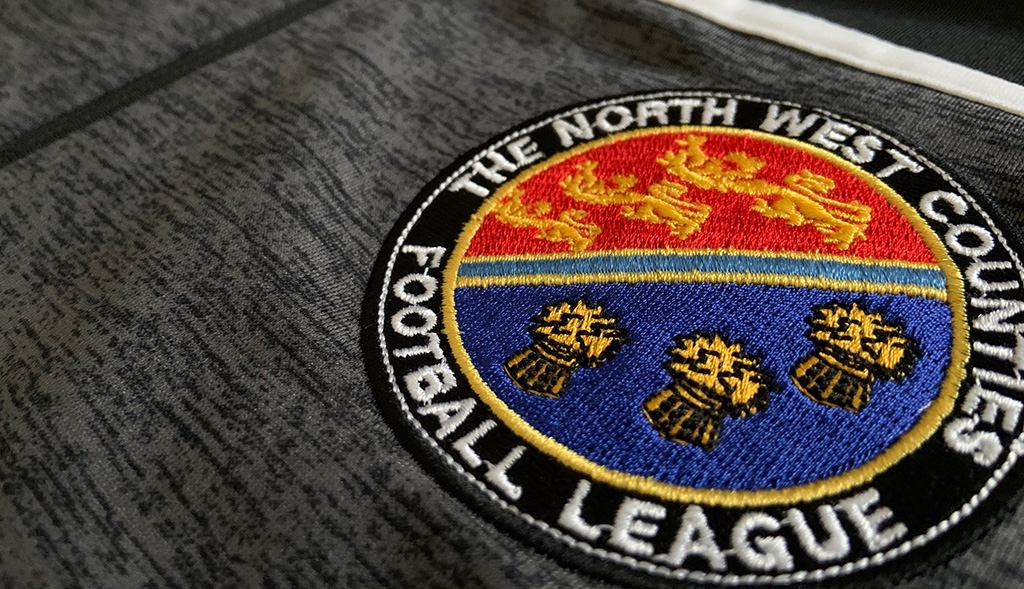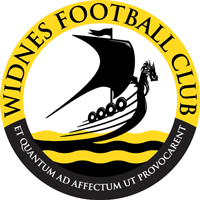
Emblematically Speaking - Widnes
Tue 29th August 2017 | Widnes | By Stewart Taylor
The Widnes FC club emblem is one of the most recently designed in the Hallmark Security League, but harks back to times long ago.
One of the dominant geographical features of our region is the River Mersey. Mention of the Mersey reminds me of one of the most regularly asked questions in football related quizzes prior to May 2011 which is; Which is the closest League football ground to the River Mersey?
Some may think that the answer is Anfield or Goodison Park but, as many will know, the answer is Stockport County or was until County were relegated to the National League at the end of the 2010-11 season.
Stockport and Liverpool define the effective start and finish of the River Mersey, and the flow of the river from east to west takes in many of the towns represented by football teams in our League.
One such town is Widnes and we see a graphical representation of the River Mersey in the bottom third of the emblem.
The River Mersey derives its name from Anglo-Saxon and means boundary river, the boundary being that between the ancient kingdoms of Northumbria and Mercia.
Northumbria covered just about the whole of the North of England in Anglo-Saxon times, and is not to be confused with the somewhat more recently formed county of the same name.
Mercia was made up of most of the Southern half of England, and there is reference to the name to this day as the West Mercia Police Force is responsible for policing in a large part of the West Midlands.
After the Viking Invasion in the 9th century, much of the country fell under the influence of Danelaw.
Danelaw can be described as a set of legal terms and definitions created in the treaties between the West-Saxon king, Alfred the Great, and the Danish warlord, Guthrum, written following Guthrum's defeat at the Battle of Edington in 878.
Part of the system of Danelaw involved Danegeld which, in part, was a system of taxation whereby money raised in England was sent to Denmark for, essentially, defensive purposes.
If anyone sees any parallels between this system, and that originally outlined by the Treaty of Rome (1957) and subsequent treaty amendments may not be too far off the mark although, so far as is recorded, there was no equivalent to Article 50 in Danelaw!
The relevance to all of this for Widnes is that the town lies north of the River Mersey which puts it into the Danelaw area and, hence, under the influence of Viking rule.
This is reflected in the incorporation of a Viking ship in the club emblem which reminds us that the club entered the North West Counties Football League as Widnes Vikings in time for the start of the 2013/14 season, and play at the Widnes Vikings RLFC stadium.
The dragon’s head on the prow of the Viking longboat is not exactly typical of standard representations of longboats. In this case it is entirely relevant, as it is a reference to the origins of Widnes FC in that the club originated as Dragons AFC, later Widnes Dragons, in 2003.
The motto – Et Quantum ad Affectum ut Provocarent (Latin) - can be translated as “To Challenge with Passion and Respect”. A sentiment which is entirely appropriate for a football club today.
The badge is described by the club as having been designed to be easily recognisable, replicated and communicated and, for me, it does exactly that, whilst respecting the history of both the town and the club.
(Our thanks to Bill Morley of Widnes FC for his contribution to this article).
 Emblematically Speaking - Widnes
Emblematically Speaking - Widnes
Tue 29th August 2017 | Widnes
By Stewart Taylor

The Widnes FC club emblem is one of the most recently designed in the Hallmark Security League, but harks back to times long ago.
One of the dominant geographical features of our region is the River Mersey. Mention of the Mersey reminds me of one of the most regularly asked questions in football related quizzes prior to May 2011 which is; Which is the closest League football ground to the River Mersey?
Some may think that the answer is Anfield or Goodison Park but, as many will know, the answer is Stockport County or was until County were relegated to the National League at the end of the 2010-11 season.
Stockport and Liverpool define the effective start and finish of the River Mersey, and the flow of the river from east to west takes in many of the towns represented by football teams in our League.
One such town is Widnes and we see a graphical representation of the River Mersey in the bottom third of the emblem.
The River Mersey derives its name from Anglo-Saxon and means boundary river, the boundary being that between the ancient kingdoms of Northumbria and Mercia.
Northumbria covered just about the whole of the North of England in Anglo-Saxon times, and is not to be confused with the somewhat more recently formed county of the same name.
Mercia was made up of most of the Southern half of England, and there is reference to the name to this day as the West Mercia Police Force is responsible for policing in a large part of the West Midlands.
After the Viking Invasion in the 9th century, much of the country fell under the influence of Danelaw.
Danelaw can be described as a set of legal terms and definitions created in the treaties between the West-Saxon king, Alfred the Great, and the Danish warlord, Guthrum, written following Guthrum's defeat at the Battle of Edington in 878.
Part of the system of Danelaw involved Danegeld which, in part, was a system of taxation whereby money raised in England was sent to Denmark for, essentially, defensive purposes.
If anyone sees any parallels between this system, and that originally outlined by the Treaty of Rome (1957) and subsequent treaty amendments may not be too far off the mark although, so far as is recorded, there was no equivalent to Article 50 in Danelaw!
The relevance to all of this for Widnes is that the town lies north of the River Mersey which puts it into the Danelaw area and, hence, under the influence of Viking rule.
This is reflected in the incorporation of a Viking ship in the club emblem which reminds us that the club entered the North West Counties Football League as Widnes Vikings in time for the start of the 2013/14 season, and play at the Widnes Vikings RLFC stadium.
The dragon’s head on the prow of the Viking longboat is not exactly typical of standard representations of longboats. In this case it is entirely relevant, as it is a reference to the origins of Widnes FC in that the club originated as Dragons AFC, later Widnes Dragons, in 2003.
The motto – Et Quantum ad Affectum ut Provocarent (Latin) - can be translated as “To Challenge with Passion and Respect”. A sentiment which is entirely appropriate for a football club today.
The badge is described by the club as having been designed to be easily recognisable, replicated and communicated and, for me, it does exactly that, whilst respecting the history of both the town and the club.
(Our thanks to Bill Morley of Widnes FC for his contribution to this article).


